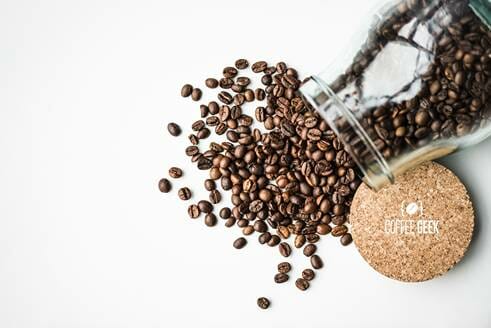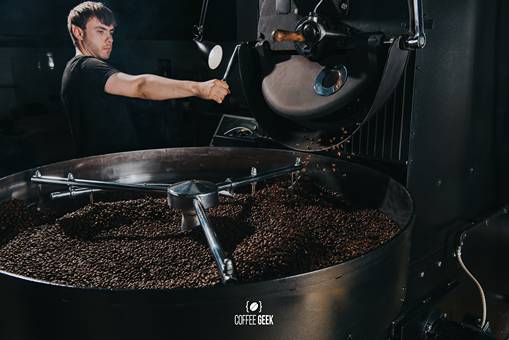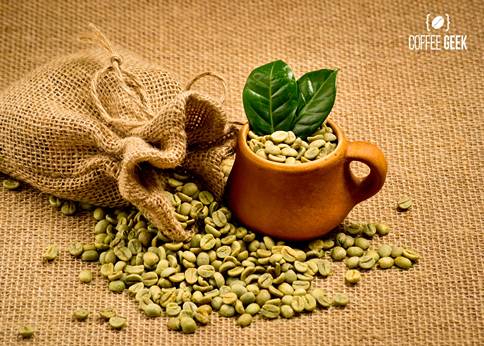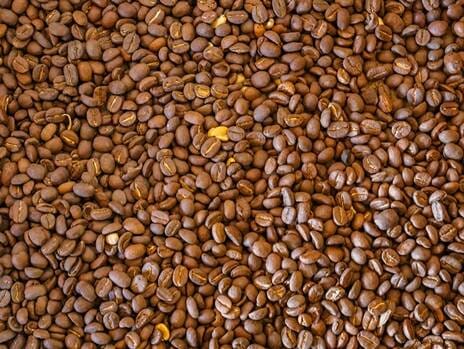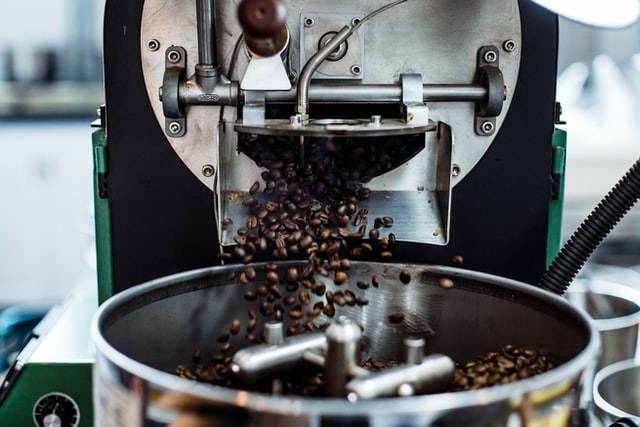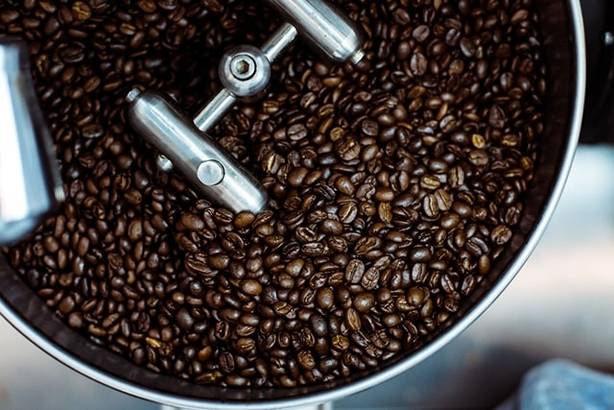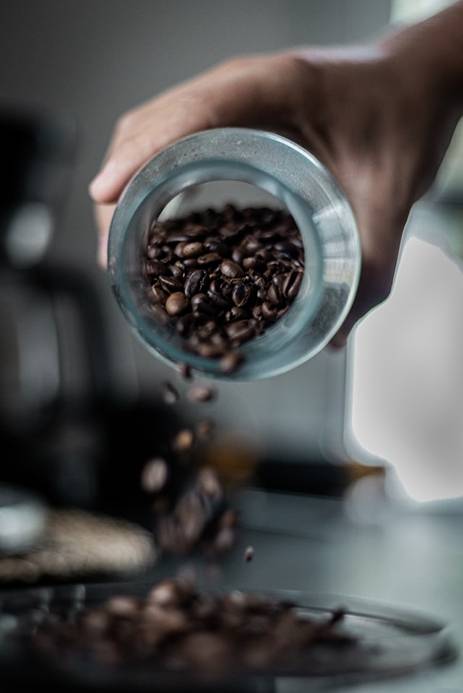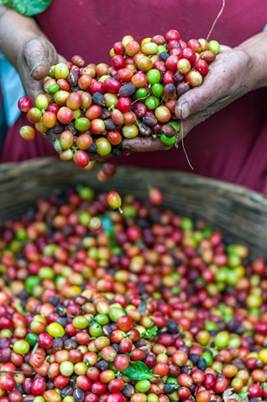Most people buy coffee beans by either the aroma or taste. Some may even buy coffee because of its origin. But, how many times have you purchased coffee because of its color?
To many, the coffee bean color represents its roast profile, which affects how the flavors are brought out.
So, what color is coffee?
In this article, we’ll answer that question in detail, and you’ll be surprised that the answer is not as simple as it may seem.
What Color is Coffee?
Roasted coffee usually has a brownish color, though it can vary from the lightest to the darkest shades.
If you love coffee and care to examine the beans closely, you can find great beauty in the colors under the right conditions.
For example, Yemen Mocha is usually a deep red, while Guatemalan dry-processed beans are yellowish-brown when raw and a deeper brown after roasting.
Light roasted Central and South American coffees from Peru and Colombia are often honey brown (although coffee from French roast cafes will be a dark brown).
Factors Affecting the Color of Coffee Beans
Here’s a quick rundown of some of the factors that affect how the color of your favorite cup of coffee turns out:
Origin
Many factors affect the aroma, flavor, and color of coffee beans.
The most crucial factor is the soil in which the coffee plants are grown.
Some countries (like Brazil) have soil that naturally produces a darker color of coffee beans than others (like Kenya).
Most coffee beans from African countries, such as Ethiopia and Kenya, are lighter in color with sweet, lively, and brighter flavors.
In contrast, coffee grown in Latin American countries like Brazil, Colombia, and Peru have a distinct earthy and rich chocolate taste and tends to be darker in color.
Altitude
Generally, beans grown in low altitudes are exposed to more ventilation and heat, giving them a more earthy and rustic flavor.
It also gives the coffee bean a deep brown color.
In contrast, coffee beans grown in high elevations worldwide tend to have a mild distinctive taste, with more of a citrusy tang.
They also tend to be lighter in color than beans from lower elevations.
Coffee Bean Grade
Coffee processors grade beans by size, ripeness, aroma, and flavor.
In Kenya, for instance, export-grade coffee is graded as AA and AB, while in Colombia, it’s known as Supremo.
Like many fruits, as coffee ripens, the coffee cherry turns from green, yellow, orange, and then dark red at harvesting.
The bigger the bean, the more mature it is, meaning it has had more time to develop its flavor profile.
Roast Levels and the Coffee Color Spectrum
Unprocessed beans need roasting to make them ready for brewing.
The length the beans are roasted (or the roast profiles) also influences the color they later adopt.
Here we detail the color, flavor, and texture changes that occur to the beans as they go through the roasting process.
First Roast
The first step of roasting occurs at 75°F (24°C).
During this stage, the coffee bean is light green.
The heat removes the moisture from the green bean forming carbon dioxide inside it.
As the green bean expands, more oxygen molecules enter and react with certain compounds known as pyrolytic compounds.
This darkens the bean’s color to a distinctive yellow-green in approximately 2 – 3 minutes.
Pale and Early Yellow Stages
The pale and early yellow stages occur at 270°F to 330°F (132 – 166°C), in which the coffee bean begins to turn yellow and lose moisture but does not expand.
The rapid increase in temperature overpowers the natural enzymes.
The aromatic oils start to coat the bean surface, and CO2 gas production occurs.
In addition, the Maillard reaction – a chemical reaction between reducing sugars and amino acids – also happens as well.
And the resulting sugar adds a tad more sweetness and complexity to the coffee beans as they turn brown.
Yellow Tan, Light Brown, and Brown Stages
This stage of the roasting process occurs at 345°F to 395°F (174 – 202°C), approximately 7 – 9 minutes into the roasting process.
As the beans are exposed to heat, they turn yellow-tan and eventually into light brown.
The process produces steam and carbon dioxide inside the beans and a characteristic toasted bread aroma.
1st Crack
When the coffee is roasted, it releases carbon dioxide.
As internal bean temperatures reach about 356°F (180°C), the carbon dioxide within is released.
This happens at around the nine-and-a-half-minute mark. The beans physically expand and get darker brown.
This stage is known as the first crack and lasts until a temperature of approximately 425°F (218°C). The process sounds distinctly like Rice Krispies or popcorn pops.
City Roast or French Roast
This roasting stage occurs at temperatures of 435°F to 454°F (224 – 234°C) at about the 11-minute mark. The next stage is the City or French Roast stage.
The surface of the coffee bean is smooth and has an oily luster.
This is when the 2nd crack happens.
The beans swell massively due to the outgassing of carbon dioxide and water.
Coffee beans at this roasting stage tend to resemble the shade of dark chocolate.
Vienna, Light Roast, or Continental Roast
This roasting stage occurs at 465°F (241°C) and is the only one that brings out the flavor notes, aromas, sugars, and flavors of different origins of coffee.
The color is still chocolate brown, but it has distinct carbon-like flavors.
Carbonized
This stage occurs at a temperature of 465°F to 485°F (241 – 252°C).
The beans are now carbonized with a wood-like bean structure.
Smoking also begins at this stage of roasting.
Imminent
By this point, the beans have fully carbonized.
They are ashy and literally on the verge of catching fire.
The beans are dark black with a texture similar to charcoal.
Video: Check out this video to understand more about the color changes that occur when you roast coffee beans:
How is the color of brewed coffee perceived on the color wheel?
Coffee colors are classic, urban, sophisticated, warm, and conservative.
This is rare among brown colors people typically perceive as earthy and rustic.
Brewed coffee is not black but a very dark brown.
Conclusion: What Color is Coffee?
I hope this article has taught you more about coffee color and its relation to coffee quality.
I hope you better understand what you’re drinking the next time you purchase a cup of coffee.
Coffee comes in a wide variety of different colors.
Remember this; some coffees of the same color can taste very different, so there’s no real need to – excuse the pun – judge a coffee by its color.
FAQs
What gives coffee its color?
The color of your coffee is determined by its origin, growing altitude, and grade. Another factor that gives coffee its color is the roast level. Green, the lightest color, is the color of unprocessed coffee. As you roast the beans, they change from tan to brown and dark brown. The longer you roast your beans, the darker brown (but not black) the beans become.
What color is black coffee?
The color of brewed black coffee depends on a variety of factors. One factor is the roast level – the darker the roast, the deeper the color of the coffee bean. Another factor is how you brew the coffee. Brewed coffee ranges from brown to a very dark brown, depending on whether you brewed it in a French press, drip coffee maker, or espresso machine.

![What Color is Coffee: Is it Black, Brown, or Something Else [Explained] 2 What Color is Coffee](https://coffeegeek.tv/wp-content/uploads/2022/07/What-Color-is-Coffee-Is-it-Black-Brown-or-Something-Else-Explained-1-1-1024x536.jpg)
